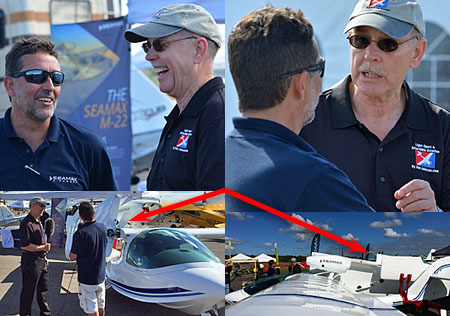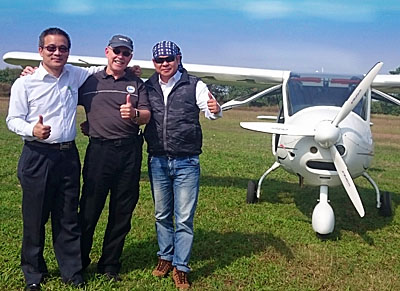
After a busy week at Sebring — a show that exceeded my expectations …and probably also for several vendors who logged sales to kick off the year in a great way — I have a couple alternative messages for readers. Those aircraft buyers at Sebring have a few weeks to wait before they get their shiny new LSA or kits but, as noted in three earlier posts, plenty of smiles were seen despite a bit more wind than many would have liked. Social Media Update If you follow Facebook, Twitter, Linked In, or Instagram as many pilots do, you may have noticed we’ve been rather quiet on those platforms. This website and Videoman Dave’s YouTube channel form our primary outlets and nothing changes that, especially now that ByDanJohnson.com has been made fully “responsive,” a tech industry term that means the BDJ2 web format now adapts readily to smartphones, tablets, TVs, or computers.


 This website and
This website and 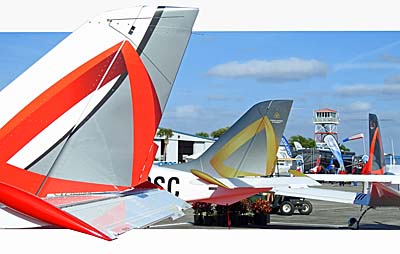 The fourteenth running of the
The fourteenth running of the 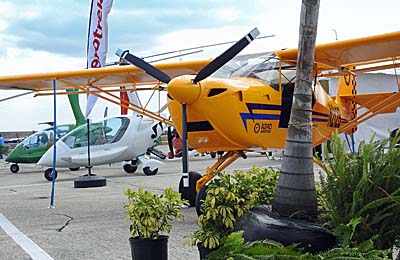
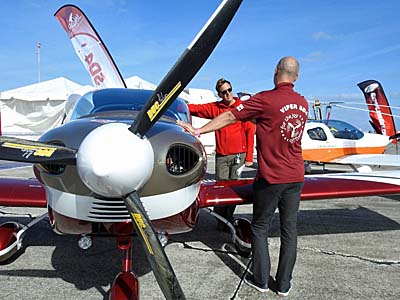
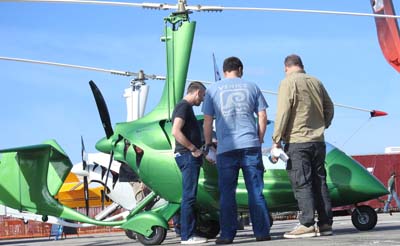

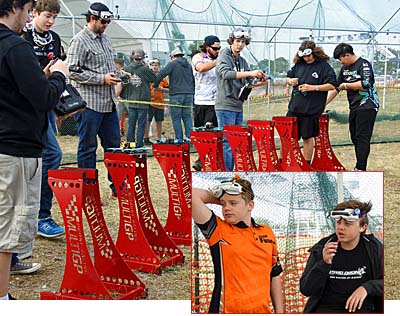
 Day two of the year's first show, Sebring was a bit cooler and windier but still a fine day as the photos show. I would guess crowds were as good or better than yesterday not even counting a large contingent of ROTC candidates visiting for the day.
Day two of the year's first show, Sebring was a bit cooler and windier but still a fine day as the photos show. I would guess crowds were as good or better than yesterday not even counting a large contingent of ROTC candidates visiting for the day.
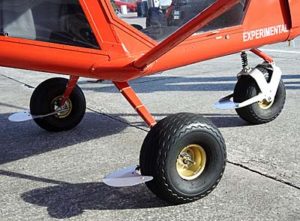 Aeroprakt USA displayed an A22LS model, the Ukraine design featuring vast expanses of clear plastic that deliver massive visibility. The show model had tundra tires with rather unique "footwear" as its tricycle gear used surfaces closer to fenders than wheel pants. They won't provide any drag reduction but will help keep mud or debris splatter off the wings and fuselage. The A-22 also had sliding windows useful for aerial photography.
Aeroprakt USA displayed an A22LS model, the Ukraine design featuring vast expanses of clear plastic that deliver massive visibility. The show model had tundra tires with rather unique "footwear" as its tricycle gear used surfaces closer to fenders than wheel pants. They won't provide any drag reduction but will help keep mud or debris splatter off the wings and fuselage. The A-22 also had sliding windows useful for aerial photography.
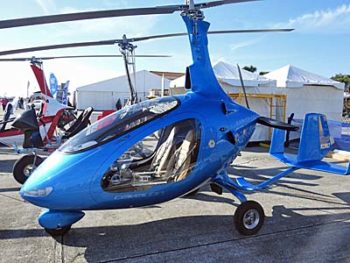 AutoGyro USA
AutoGyro USA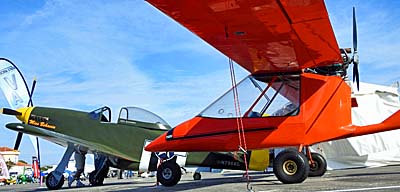 It was fun to get caught up with John Williams of
It was fun to get caught up with John Williams of 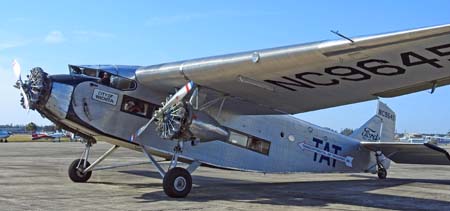
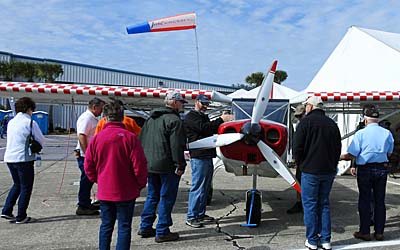
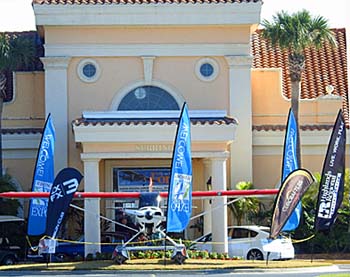
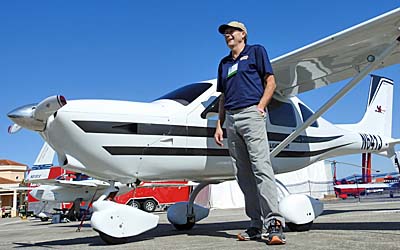
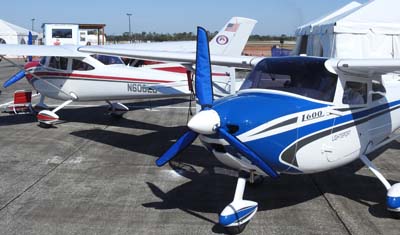
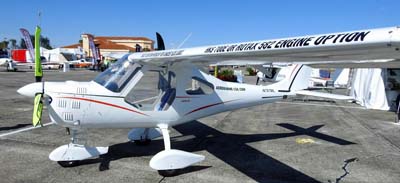 Tomorrow's forecast:
Tomorrow's forecast: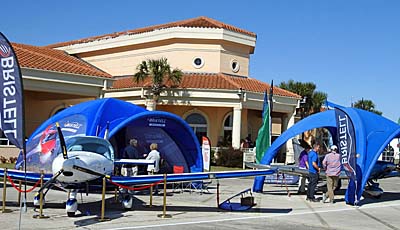
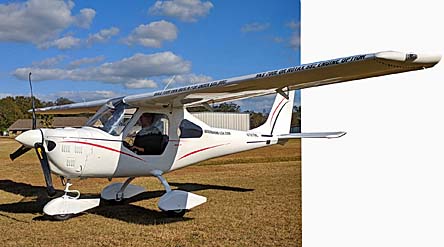
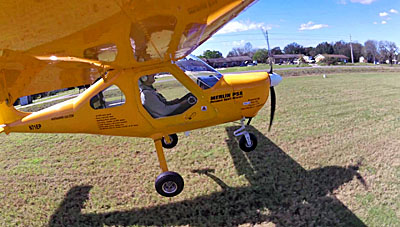
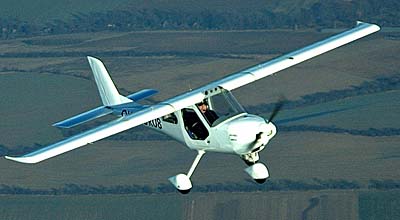 Chip continued, "The crisp performance hasn’t changed [with the HKS versus the Rotax 582]. In fact, the early tests are showing near-identical takeoff and climb, but with higher cruise numbers, compared to the Merlin with the Rotax 582 two-stroke." The Rotax engine outputs 65 horsepower while the HKS has 60. Two-stroke engines also spool up quicker than a four stroke. However, the HKS offers higher torque, useful during launch and climb out.
The four-stroke, horizontally-opposed, two-cylinder HKS and its gearbox "weighs a bit more" than the two-stroke option, Chip noted.
“We moved the battery aft, and the whole airplane gives up about twenty pounds of payload,” Chip said, “but the HKS burns less fuel so its flight time is longer at any given weight.” Another positive: HKS can run on avgas or premium mogas.
Chip continued, "The crisp performance hasn’t changed [with the HKS versus the Rotax 582]. In fact, the early tests are showing near-identical takeoff and climb, but with higher cruise numbers, compared to the Merlin with the Rotax 582 two-stroke." The Rotax engine outputs 65 horsepower while the HKS has 60. Two-stroke engines also spool up quicker than a four stroke. However, the HKS offers higher torque, useful during launch and climb out.
The four-stroke, horizontally-opposed, two-cylinder HKS and its gearbox "weighs a bit more" than the two-stroke option, Chip noted.
“We moved the battery aft, and the whole airplane gives up about twenty pounds of payload,” Chip said, “but the HKS burns less fuel so its flight time is longer at any given weight.” Another positive: HKS can run on avgas or premium mogas.
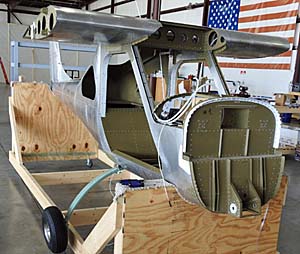 “We will bring a Merlin from our build program that isn’t yet 100% completed,” said Chip. "That will give people a chance to see how easy it is to build their own Merlin.” The fully enclosed Merlin claims to be one of the quickest-build 51% kits available.
I went to observe a customer building his own Merlin to see how easy and quick it really was. I came away suitably impressed.
"So complete and builder-ready is the Quick Build Kit that most major assemblies and skins are already tacked into position for shipping (using colored soft rivets)," Chip explained, "requiring the builder to actually do some disassembly to bring it to the 51% stage."
“There is no 'Slow Build' option,” deadpanned Erwin in his characteristic humor.
“Precision matched-hole technology means that the holes punched are not just pilot holes; the accuracy is so high that holes in the skins match the holes in the ribs and bulkheads at final size, so next to zero drilling is required," Chip said. "This precision saves dozens if not hundreds of assembly time hours.” My own eyes proved to me that this precision matched-hole technology works as advertised.
“We will bring a Merlin from our build program that isn’t yet 100% completed,” said Chip. "That will give people a chance to see how easy it is to build their own Merlin.” The fully enclosed Merlin claims to be one of the quickest-build 51% kits available.
I went to observe a customer building his own Merlin to see how easy and quick it really was. I came away suitably impressed.
"So complete and builder-ready is the Quick Build Kit that most major assemblies and skins are already tacked into position for shipping (using colored soft rivets)," Chip explained, "requiring the builder to actually do some disassembly to bring it to the 51% stage."
“There is no 'Slow Build' option,” deadpanned Erwin in his characteristic humor.
“Precision matched-hole technology means that the holes punched are not just pilot holes; the accuracy is so high that holes in the skins match the holes in the ribs and bulkheads at final size, so next to zero drilling is required," Chip said. "This precision saves dozens if not hundreds of assembly time hours.” My own eyes proved to me that this precision matched-hole technology works as advertised.
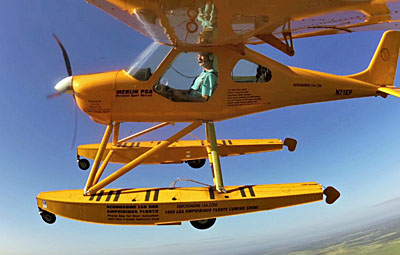
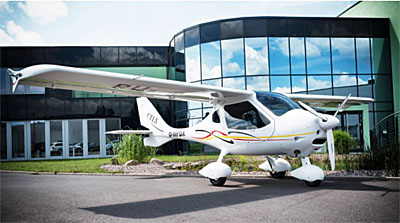
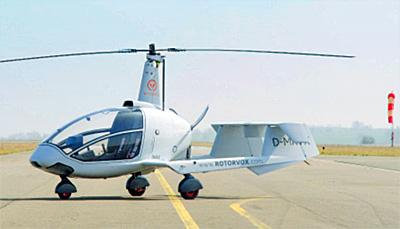

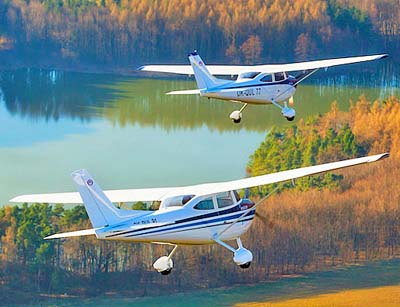 This website was born in 2004 after a few years of laboriously uploading a large number of written pilot reports that had appeared in aviation print magazines over the years before. It was tougher to do then than it is now.
The project started in late 1999, barely four years after the World Wide Web was built on the Internet. Tools were crude then and it proved to be a multi-year project to convert from print to web. Today, such a task is vastly easier and we hope you are enjoying the
This website was born in 2004 after a few years of laboriously uploading a large number of written pilot reports that had appeared in aviation print magazines over the years before. It was tougher to do then than it is now.
The project started in late 1999, barely four years after the World Wide Web was built on the Internet. Tools were crude then and it proved to be a multi-year project to convert from print to web. Today, such a task is vastly easier and we hope you are enjoying the 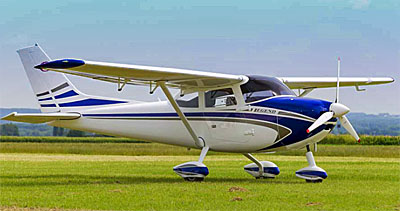 Think about this. In 1999, Google was hardly known; it formed in September 1998. Facebook started in February 2004 and YouTube went live a year later in February 2005. Apple's iPhone ushered in the era of smartphones in fall 2007.
Today, video is everywhere and I'm proud we've kept up with the times — even having our own
Think about this. In 1999, Google was hardly known; it formed in September 1998. Facebook started in February 2004 and YouTube went live a year later in February 2005. Apple's iPhone ushered in the era of smartphones in fall 2007.
Today, video is everywhere and I'm proud we've kept up with the times — even having our own 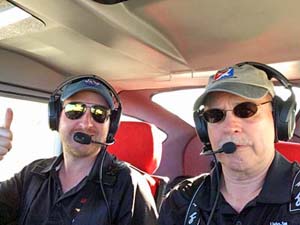
 Also, please remember all the hyperlinks embedded in articles take you all over this website with its 1,500 or so pages packed to the edges with all kinds of info about Light-Sport Aircraft, light kit-built aircraft, and ultralight aircraft …our singular focus in aviation.
Aeropilot USA sells L600 starting below $100,000 (but see RT for prices in 2024), at which price it makes a great value in a sleek yet familiar shape. You can check it out further if you attend
Also, please remember all the hyperlinks embedded in articles take you all over this website with its 1,500 or so pages packed to the edges with all kinds of info about Light-Sport Aircraft, light kit-built aircraft, and ultralight aircraft …our singular focus in aviation.
Aeropilot USA sells L600 starting below $100,000 (but see RT for prices in 2024), at which price it makes a great value in a sleek yet familiar shape. You can check it out further if you attend 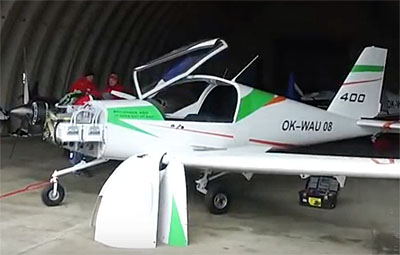 As the world appears to shift into overdrive about electric cars, planes, and drones, what is happening in this dynamic, unfolding sector in aviation?
Recent news from Pipistrel spoke to their continued development of their
As the world appears to shift into overdrive about electric cars, planes, and drones, what is happening in this dynamic, unfolding sector in aviation?
Recent news from Pipistrel spoke to their continued development of their 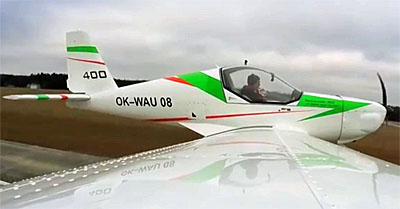 The Skyleader company is somewhat known in the USA although perhaps by their earlier name Kappa. The more correct name was and is Jihlavan Airplanes but Skyleader is a better marketing name.
Americans have seen examples of the company's top-of-the-line Skyleader 600 — here's
The Skyleader company is somewhat known in the USA although perhaps by their earlier name Kappa. The more correct name was and is Jihlavan Airplanes but Skyleader is a better marketing name.
Americans have seen examples of the company's top-of-the-line Skyleader 600 — here's 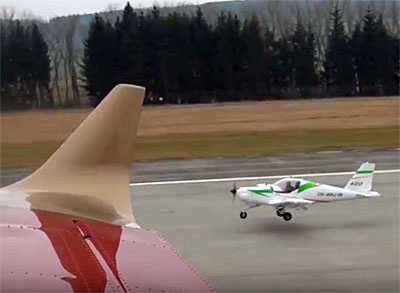 Meanwhile, rather quietly, Skyleader made first flights on their pure electric (that is, not hybrid) light aircraft.
Based on their intermediate model,
Meanwhile, rather quietly, Skyleader made first flights on their pure electric (that is, not hybrid) light aircraft.
Based on their intermediate model, 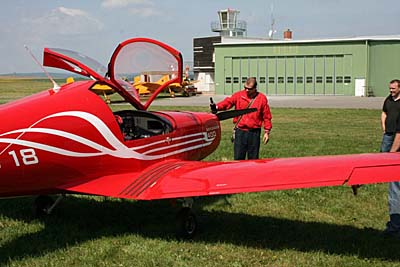 I believe no doubt exists that the first successes of electric aircraft will be those that are lightest. Electric already works well in genuine Part 103 ultralights. Pioneer Randall Fishman and Mark Bierle have been flying with electric power for years. An
I believe no doubt exists that the first successes of electric aircraft will be those that are lightest. Electric already works well in genuine Part 103 ultralights. Pioneer Randall Fishman and Mark Bierle have been flying with electric power for years. An 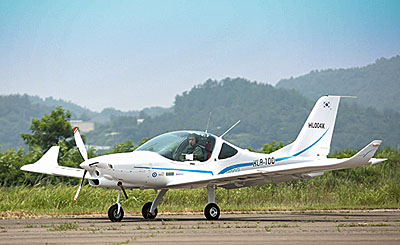

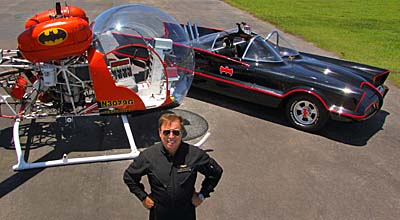 Amazingly, "Holy Batcopter!" was not one of the 368 different "Holy..." exclamations uttered by the Robin character in the 1960s TV series. The iconic Bell 47 chopper — without Robin or Batman — will make an appearance at the
Amazingly, "Holy Batcopter!" was not one of the 368 different "Holy..." exclamations uttered by the Robin character in the 1960s TV series. The iconic Bell 47 chopper — without Robin or Batman — will make an appearance at the 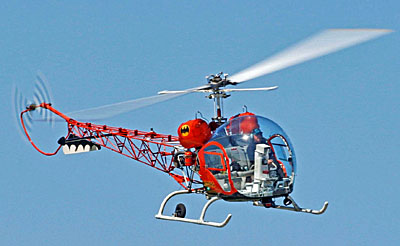 That’s why Nock — an airline transport pilot who has logged more than 14,000 hours — will be flying this vintage flying machine at the upcoming Sebring Expo. Nock hopes to inspire young people to find a future in either law enforcement, military, or becoming a pilot, said Sebring Expo's PR agency.
A noon show featuring the Batcopter and Batmobile is scheduled for Friday, January 26 and Saturday, January 27.
Rides in the three-seat chopper can be purchased at the event with no need to reserve in advance. Cost: Adults $100; children & students (17 & under) $70.
Nock, who’s been a pilot since age 17, said his father was in the entertainment business and worked with Adam West (the original Batman) in the 1960s in California. Nock said he met West in the late '60s.
That’s why Nock — an airline transport pilot who has logged more than 14,000 hours — will be flying this vintage flying machine at the upcoming Sebring Expo. Nock hopes to inspire young people to find a future in either law enforcement, military, or becoming a pilot, said Sebring Expo's PR agency.
A noon show featuring the Batcopter and Batmobile is scheduled for Friday, January 26 and Saturday, January 27.
Rides in the three-seat chopper can be purchased at the event with no need to reserve in advance. Cost: Adults $100; children & students (17 & under) $70.
Nock, who’s been a pilot since age 17, said his father was in the entertainment business and worked with Adam West (the original Batman) in the 1960s in California. Nock said he met West in the late '60s.
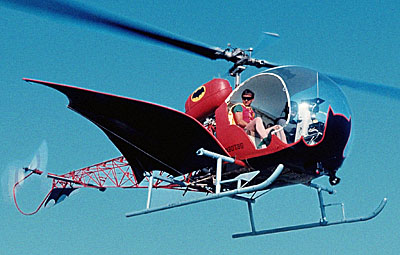 The Batcopter was a functional helicopter provided by National Helicopter Service. It was based on the Bell 47, which was designed by Bell Helicopter Textron in 1941. The Batcopter was a G3B-1 model, which had previously been used in "Lassie Come Home" and "ABC News."
To make the model look more like a superhero vehicle, it was fitted with canvas-covered tubular frames and was painted red. The head of a bat was painted in the front while the Batman symbol was painted on the side. The most dangerous design change was the wings, which reduced power by nearly 50%.
For the scenes at sea, the Batcopter was taped at Marineland of the Pacific in Palos Verdes, California. Most of the shots were relatively far away as the pilot was Harry Haus, not Adam West, the actor playing Batman. Hubie Kerns donned the Batman outfit to perform the stunts, namely climbing the rope ladder attached to the helicopter while kicking an exploding shark.
* Thanks to Wikipedia for all the BatInfo.
The Batcopter was a functional helicopter provided by National Helicopter Service. It was based on the Bell 47, which was designed by Bell Helicopter Textron in 1941. The Batcopter was a G3B-1 model, which had previously been used in "Lassie Come Home" and "ABC News."
To make the model look more like a superhero vehicle, it was fitted with canvas-covered tubular frames and was painted red. The head of a bat was painted in the front while the Batman symbol was painted on the side. The most dangerous design change was the wings, which reduced power by nearly 50%.
For the scenes at sea, the Batcopter was taped at Marineland of the Pacific in Palos Verdes, California. Most of the shots were relatively far away as the pilot was Harry Haus, not Adam West, the actor playing Batman. Hubie Kerns donned the Batman outfit to perform the stunts, namely climbing the rope ladder attached to the helicopter while kicking an exploding shark.
* Thanks to Wikipedia for all the BatInfo.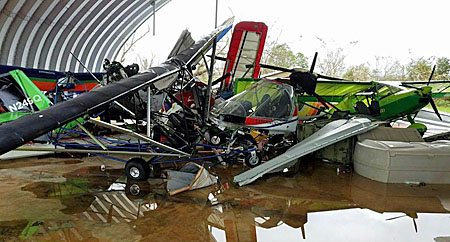

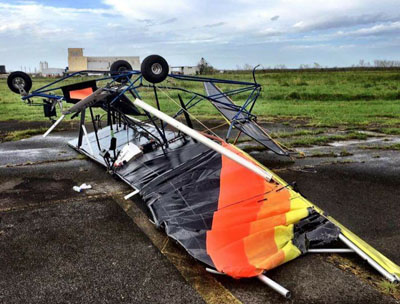
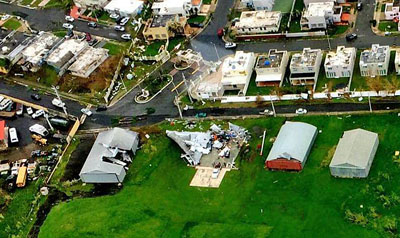
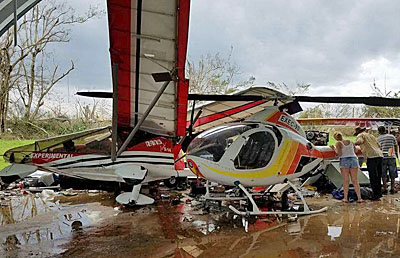
 When I first saw
When I first saw 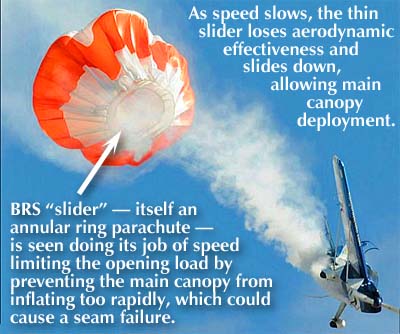 This deployment can be viewed through a video from inside the cockpit. It's fairly poor but does show a pilot trying other solutions but when unable to regain control, he deploys the parachute. If you check
This deployment can be viewed through a video from inside the cockpit. It's fairly poor but does show a pilot trying other solutions but when unable to regain control, he deploys the parachute. If you check 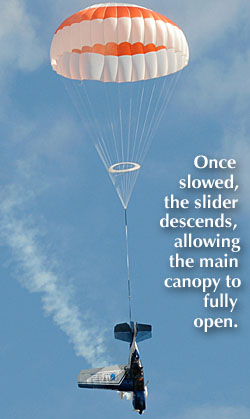 Here are some portions of the article, which relates, "At the start of the clip the pilot is seen trying to steady the plane as it rapidly descends while spinning around." Remember, this is a test pilot exploring the flight qualities and performance parameters of a Light-Sport Aircraft, which I agreed not to name (but it was obvious to me that this was not the aircraft in the still picture Daily Mail used).
Here are some portions of the article, which relates, "At the start of the clip the pilot is seen trying to steady the plane as it rapidly descends while spinning around." Remember, this is a test pilot exploring the flight qualities and performance parameters of a Light-Sport Aircraft, which I agreed not to name (but it was obvious to me that this was not the aircraft in the still picture Daily Mail used).
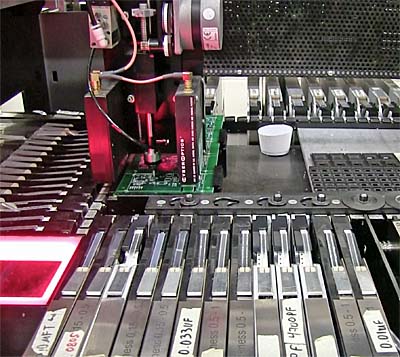
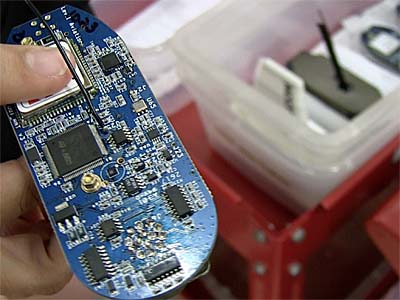
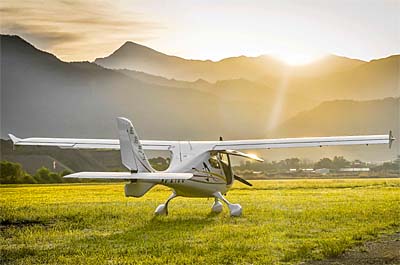 My guess is most readers do not care particularly about recreational aviation or sport flying in China. After speaking to many pilots at airshows, I know Americans are somewhat aware of flying in other nations but we enjoy so much freedom to fly in the USA and we have so many choices of aircraft, airports, and flying gear that the rest of the world seems almost irrelevant.
We most definitely are the lucky ones. We can and do take for granted the idea of hopping in your airplane — whether ultralight, LSA, or a speedy four passenger GA aircraft — and flying to a pancake breakfast or for one of those $100 hamburgers. We can fly almost anywhere we want, anytime we choose, for hour after hour if we like. Sure, some airspace is closed to us or perhaps too congested but, by and large, we can do what we want in the air. I love it. You love it. People in other countries want to love it.
My guess is most readers do not care particularly about recreational aviation or sport flying in China. After speaking to many pilots at airshows, I know Americans are somewhat aware of flying in other nations but we enjoy so much freedom to fly in the USA and we have so many choices of aircraft, airports, and flying gear that the rest of the world seems almost irrelevant.
We most definitely are the lucky ones. We can and do take for granted the idea of hopping in your airplane — whether ultralight, LSA, or a speedy four passenger GA aircraft — and flying to a pancake breakfast or for one of those $100 hamburgers. We can fly almost anywhere we want, anytime we choose, for hour after hour if we like. Sure, some airspace is closed to us or perhaps too congested but, by and large, we can do what we want in the air. I love it. You love it. People in other countries want to love it.
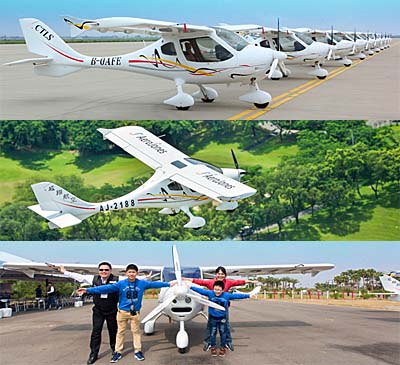
 I have zero doubt China can build the airports. It is perfectly obvious this industrious country can build anything — literally anything — they want. I've never seen so many construction cranes and this is true nearly everywhere you look.
In the central city of Anyang, billing itself as the sport flying capital of China, I toured a massive construction development. It will include the usual collection of very large buildings complete with a handsome new airport and runway but also an airport flying community, roughly imitating the one in which I live:
I have zero doubt China can build the airports. It is perfectly obvious this industrious country can build anything — literally anything — they want. I've never seen so many construction cranes and this is true nearly everywhere you look.
In the central city of Anyang, billing itself as the sport flying capital of China, I toured a massive construction development. It will include the usual collection of very large buildings complete with a handsome new airport and runway but also an airport flying community, roughly imitating the one in which I live: 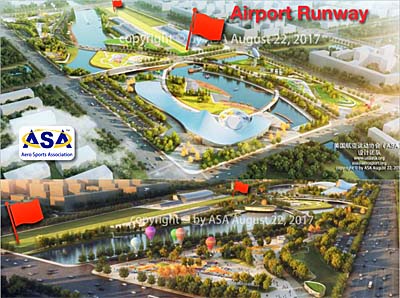
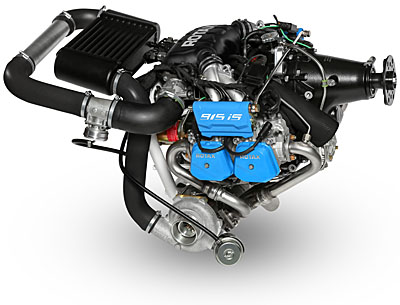
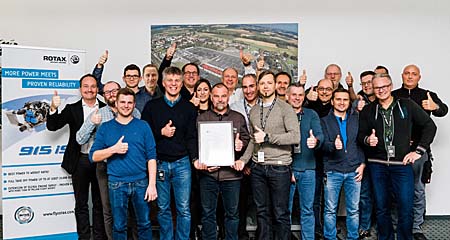 They added, "It will also offer the possibility to carry up to four persons" for aircraft such as
They added, "It will also offer the possibility to carry up to four persons" for aircraft such as  You know this decades-old company for their popular
You know this decades-old company for their popular 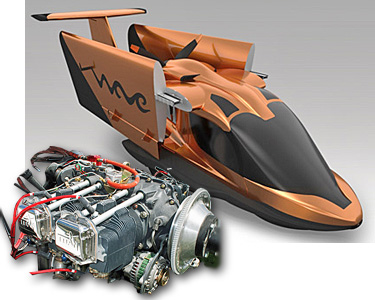
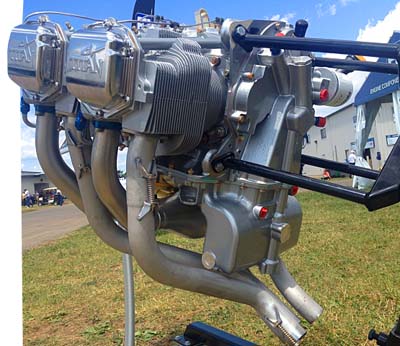 The new quarters will include office and manufacturing spaces and Continental Motors plans to invest more than $70 million in the latest manufacturing equipment, a modern new building, advanced manufacturing processes, quality management systems, and customer support.
Continental Motors Group is a subsidiary of AVIC International Holding Corporation of Beijing, China. The Alabama manufacturer offers gasoline and diesel piston engines, spare parts, engine and aircraft services, avionics equipment and repairs as well as pilot training for the general aviation marketplace. Continental is an international operation employing approximately 450 staff in Mobile, Alabama, 200 more in St. Egidien, Germany; and another eight in Beijing, China.
Established in 1979, AVIC International Holding Corporation boasts 80,000 employees across 400 subsidiaries spread over 50 countries.
Congratulations, Continental!
The new quarters will include office and manufacturing spaces and Continental Motors plans to invest more than $70 million in the latest manufacturing equipment, a modern new building, advanced manufacturing processes, quality management systems, and customer support.
Continental Motors Group is a subsidiary of AVIC International Holding Corporation of Beijing, China. The Alabama manufacturer offers gasoline and diesel piston engines, spare parts, engine and aircraft services, avionics equipment and repairs as well as pilot training for the general aviation marketplace. Continental is an international operation employing approximately 450 staff in Mobile, Alabama, 200 more in St. Egidien, Germany; and another eight in Beijing, China.
Established in 1979, AVIC International Holding Corporation boasts 80,000 employees across 400 subsidiaries spread over 50 countries.
Congratulations, Continental!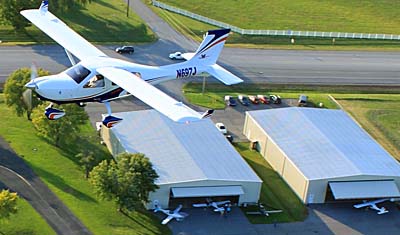
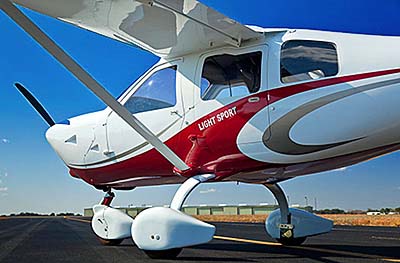
 “[Selling new Jabiru aircraft] complements our brokerage, acquisition, and pre-owned sales business," explained Scott. However, this does not mean US Sport Planes will stop working with other brands.
Scott clarified, "We will continue repair and maintenance services for Jabiru aircraft and engines as well as Rotax engines plus factory-authorized service for Flight Design, Tecnam, and most major LSA aircraft. The expansion will increase Jabiru customer support overall."
Unusual to Light Sport Aircraft is the three-door entry ease and interior roominess of the J230-D Jabiru aircraft. The model started out as a four seater kit aircraft in Australia and was repositioned as a two-seat model to fit American FAA regulations for Special Light-Sport Aircraft. "With the new, improved J230-D model and Jabiru’s new Gen IV engine," Scott added, "I’m pleased to help more pilots get into these 'Cabin Class' Light-Sport Aircraft.”
“[Selling new Jabiru aircraft] complements our brokerage, acquisition, and pre-owned sales business," explained Scott. However, this does not mean US Sport Planes will stop working with other brands.
Scott clarified, "We will continue repair and maintenance services for Jabiru aircraft and engines as well as Rotax engines plus factory-authorized service for Flight Design, Tecnam, and most major LSA aircraft. The expansion will increase Jabiru customer support overall."
Unusual to Light Sport Aircraft is the three-door entry ease and interior roominess of the J230-D Jabiru aircraft. The model started out as a four seater kit aircraft in Australia and was repositioned as a two-seat model to fit American FAA regulations for Special Light-Sport Aircraft. "With the new, improved J230-D model and Jabiru’s new Gen IV engine," Scott added, "I’m pleased to help more pilots get into these 'Cabin Class' Light-Sport Aircraft.”
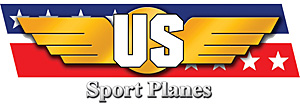 Pete Krotje and Jabiru North America has been the Jabiru importer for North America for 18 years. His business will continue its current activity of engine and firewall forward sales as well as providing parts, service and technical support for all Jabiru products from its current location in Shelbyville, TN. For more information, Contact Pete Krotje at
Pete Krotje and Jabiru North America has been the Jabiru importer for North America for 18 years. His business will continue its current activity of engine and firewall forward sales as well as providing parts, service and technical support for all Jabiru products from its current location in Shelbyville, TN. For more information, Contact Pete Krotje at 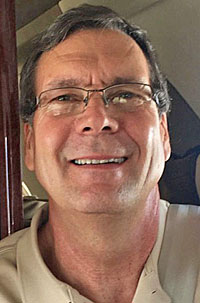 The son of a career Air Force fighter pilot, Scott learned early about aviation as a lifestyle. He began building and flying hang gliders in 1973 and joined USHGA, United States Hang Gliding Association. In the early 1980s, he founded and operated Lone Star Airpark to provide facilities, services and flight instruction for ultralights, and eventually became a USUA, United States Ultralight Association AFI, Advanced Flight Instructor, AFI Examiner, and AFI Seminar Presenter. Scott also volunteered as a director and interim president of USUA, United States Ultralight Association.
In the early 1990s, he and his family moved to Tennessee where he served as president of TEAM Aircraft.
Always willing to help the industry Scott assisted the AOOA, Airpark Owners and Operators Association as its first president. In the mid-nineties he served as president of LAMA, Light Aircraft Manufacturers Association and in 2017 he rejoined LAMA to serve on the board of directors.
Scott also participated as a charter member of the Part 103 FAA ARAC, Aviation Rule-making Advisory Committee that eventually created the Light-Sport Aircraft and Sport Pilot regulations.
The son of a career Air Force fighter pilot, Scott learned early about aviation as a lifestyle. He began building and flying hang gliders in 1973 and joined USHGA, United States Hang Gliding Association. In the early 1980s, he founded and operated Lone Star Airpark to provide facilities, services and flight instruction for ultralights, and eventually became a USUA, United States Ultralight Association AFI, Advanced Flight Instructor, AFI Examiner, and AFI Seminar Presenter. Scott also volunteered as a director and interim president of USUA, United States Ultralight Association.
In the early 1990s, he and his family moved to Tennessee where he served as president of TEAM Aircraft.
Always willing to help the industry Scott assisted the AOOA, Airpark Owners and Operators Association as its first president. In the mid-nineties he served as president of LAMA, Light Aircraft Manufacturers Association and in 2017 he rejoined LAMA to serve on the board of directors.
Scott also participated as a charter member of the Part 103 FAA ARAC, Aviation Rule-making Advisory Committee that eventually created the Light-Sport Aircraft and Sport Pilot regulations.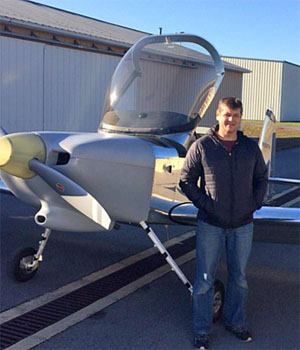 According to a
According to a 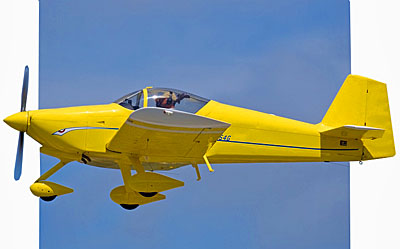
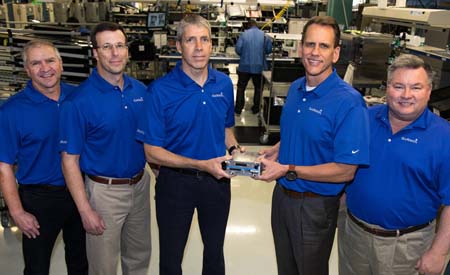 “Since our inception over 28 years ago, Garmin has been committed to providing superior products that are known for their innovation, reliability and intuitive design,” said Phil Straub, Garmin executive vice president, managing director of aviation. “This milestone is a testament to our long-established commitment to making significant investments in research and development, as well as the hard work and dedication of thousands of passionate Garmin team members that I have the pleasure of working with every day.”
“As we celebrate this exciting accomplishment, I am very proud of how our teams have managed such significant growth, while maintaining the culture of our company as our founders set forth,” said Carl Wolf, vice president of aviation marketing and sales. “The breadth and depth of our certified aviation product line has expanded greatly over the years, allowing us to develop new markets for Garmin. This incredible milestone doesn’t even include the hundreds of thousands of portable and other non-certified products that our customers use every day. On behalf of Garmin, I wish to express my utmost gratitude to our loyal customers, our dealers and the aircraft manufacturers all around the globe, who have helped us to accomplish such a tremendous achievement in Garmin’s history.”
“Since our inception over 28 years ago, Garmin has been committed to providing superior products that are known for their innovation, reliability and intuitive design,” said Phil Straub, Garmin executive vice president, managing director of aviation. “This milestone is a testament to our long-established commitment to making significant investments in research and development, as well as the hard work and dedication of thousands of passionate Garmin team members that I have the pleasure of working with every day.”
“As we celebrate this exciting accomplishment, I am very proud of how our teams have managed such significant growth, while maintaining the culture of our company as our founders set forth,” said Carl Wolf, vice president of aviation marketing and sales. “The breadth and depth of our certified aviation product line has expanded greatly over the years, allowing us to develop new markets for Garmin. This incredible milestone doesn’t even include the hundreds of thousands of portable and other non-certified products that our customers use every day. On behalf of Garmin, I wish to express my utmost gratitude to our loyal customers, our dealers and the aircraft manufacturers all around the globe, who have helped us to accomplish such a tremendous achievement in Garmin’s history.”
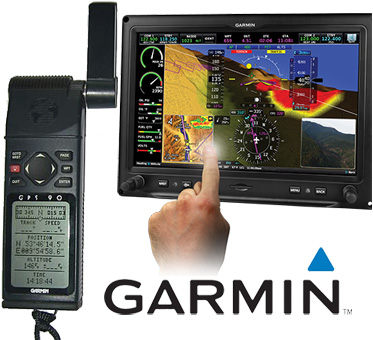

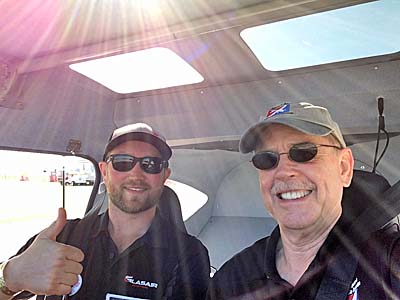

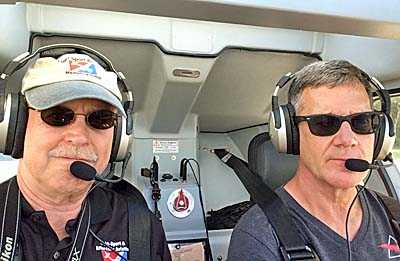
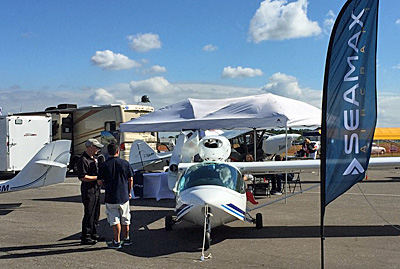 Years ago, back in the early days of the Light-Sport Aircraft sector exploding into the world of aviation, of affordable aviation, one of the early entries was SeaMax, from a Brazilian-based company called
Years ago, back in the early days of the Light-Sport Aircraft sector exploding into the world of aviation, of affordable aviation, one of the early entries was SeaMax, from a Brazilian-based company called 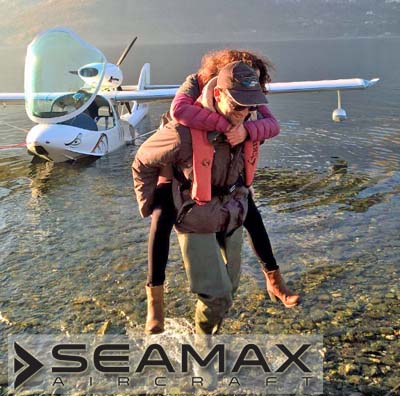 SeaMax also has dashing looks. I likened it to a high-end speedboat …one that flies! Plus, it was comfortable to get in and to be in. All good.
Yet a problem subsequently arose. The 2008 financial meltdown happened, sales slowed, and Carlos moved on to other flying. Sometime later, SeaMax attracted the interest of another player, whose involvement ironically served to dampen interest. The interim party promised changes (probably unnecessary) and possibly caused prospective buyers to think, "Well, I'll wait to see those changes and then maybe I'll go for it." Those changes never came.
Flash forward to late 2017.
All the confusion that reigned for a few years is now officially over. I've seen copies of court documents that prove designer and company leader Miguel Rosario is now back at the helm. This clarifies the situation for buyers.
In addition, with support from U.S. representative, Shalom Confessor, SeaMax has entered into an agreement with the world's leading aeronautical university,
SeaMax also has dashing looks. I likened it to a high-end speedboat …one that flies! Plus, it was comfortable to get in and to be in. All good.
Yet a problem subsequently arose. The 2008 financial meltdown happened, sales slowed, and Carlos moved on to other flying. Sometime later, SeaMax attracted the interest of another player, whose involvement ironically served to dampen interest. The interim party promised changes (probably unnecessary) and possibly caused prospective buyers to think, "Well, I'll wait to see those changes and then maybe I'll go for it." Those changes never came.
Flash forward to late 2017.
All the confusion that reigned for a few years is now officially over. I've seen copies of court documents that prove designer and company leader Miguel Rosario is now back at the helm. This clarifies the situation for buyers.
In addition, with support from U.S. representative, Shalom Confessor, SeaMax has entered into an agreement with the world's leading aeronautical university, 